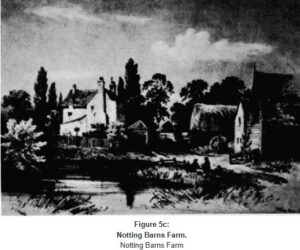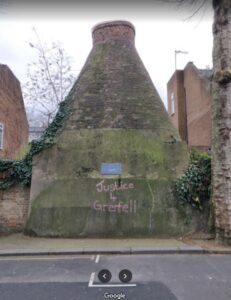In the 18th century, Northern Kensington was mainly agricultural land supplying hay to the London market. Two farms, Notting Barns and Portobello – named in honour of the capture of Puerto Bello (in what is now Panama) by Admiral Vernon in 1739 – dominated the area, occupying around 400 acres of land.
 Notting Barns, encompassed 150 acres, and was mainly used for dairy farming. The old farm house was finally demolished in 1880. Portobello Farm with its vast cornfields and meadow-land was sold in 1866 for building purposes.
Notting Barns, encompassed 150 acres, and was mainly used for dairy farming. The old farm house was finally demolished in 1880. Portobello Farm with its vast cornfields and meadow-land was sold in 1866 for building purposes.
The area in the west, around Pottery Lane, was used for making bricks and tiles out of the clay dug in the area. An old kiln still stands in Walmer Road. Then pig farmers moved in having been forced out of the central London, which gave the area the name of “potteries and piggeries”.
In the early years of the 19th century certain merchants with noxious trades had to move from residential areas of London to more isolated and solitary districts and they all moved to the area. The whole district then became overpopulated with pigs, people and environmentally harmful traders. The authorities turned a blind eye to the situation and the conditions went from bad to worse.
After the cholera epidemic of 1848–9 the inhabitants of the potteries were living and dying in conditions of filth, disease and insanitation and this gave the area a notoriety, unsurpassed by any other district in London.
The pigs did eventually go, but the poor conditions remained, overcrowding being the main concern.
The area started to change when the clay pits were filled in and Avondale Park was created in 1892 out of a former area of pig slurry called ‘the Ocean’.
By 1894, extensive new building was taking place on the ground to the west and north-west of the Potteries.
Stephen Bird had started to build on the sixteen acres of his brick-field, shortly before his death in 1865 and new houses were also springing up in great numbers on the land further north.
Here the principal developer was James Whitchurch, an attorney from Southampton, who purchased 50 acres of land for £10 an acre, in the 19th century. He left his home in Blechynden in Southampton and built himself a house in Lancaster Road.
Streets were built on the estate in 1846, and the first were named Aldermaston, Silchester, Bramley and Pamber after four neighbouring villages near Basingstoke

which was where James Whitchurch’s daughter Florence Blechynden Whitchurch was living.
After dividing the land into plots, he leased them to people like, John Calverley (Calverley St) a Notting Hill builder, Joseph Job Martin, the landlord of The Lancaster Tavern in Walmer Road, and the developer of Martin Street, Stephen Hurst, a builder from Kentish Town, who was responsible for Hurstway Street and James Fowell of Gray’s Inn Road, who moved to Ponders End with the profits from Fowell Street.
It is well documented that Notting Dale was once an area known for its slum housing but it has risen like a phoenix from the ashes and is now considered a trendy, upmarket and exclusive area, with beautiful private houses alongside well- built local authority housing estates.